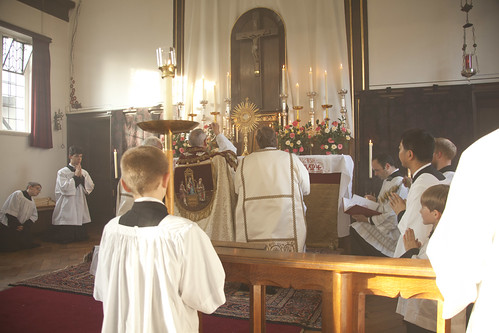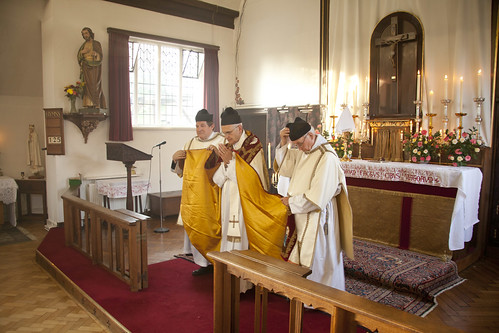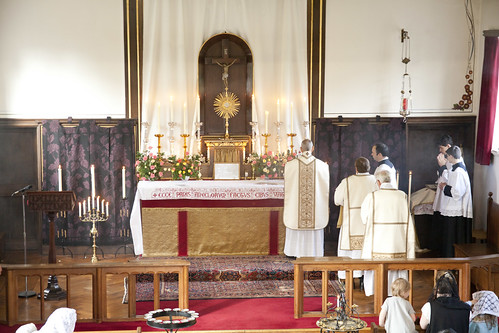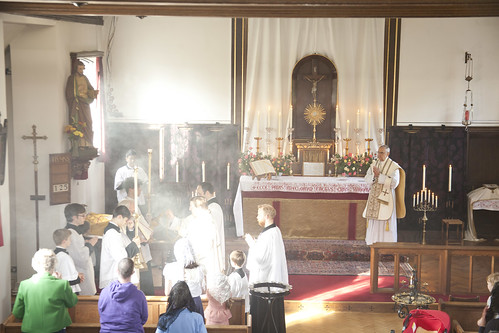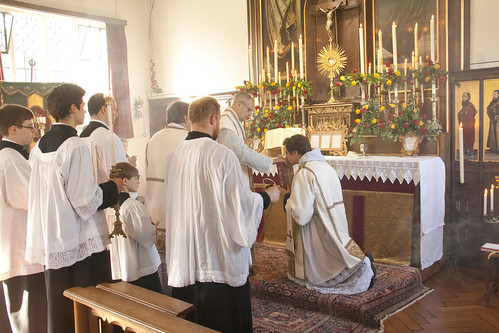Chairman's Blog
What happened to hats? Christian Dior speaks
 |
| Bishop Cunningham was too polite to notice, but others did. |
Reposted from March 2015.
------------------------------------------
A short time ago I published a position paper on head coverings in church. In the Church's tradition, going back to the Apostles, men uncover their heads, and women cover them, during the liturgy. Men removing their hats is still demanded throughout the Church in practice: deviation from the custom is noted with a degree of shock. The custom of women covering them is widely, if not universally, observed in the context of the Traditional Mass, as well as being maintained in the Eastern Churches, but is seen in the Ordinary Form only when grand weddings demand hats for the ladies.
A complicating cultural factor is the disappearance, to an overwhelming extent, of headcoverings for both sexes in everyday life in Western fashion. This means that the liturgical custom looks like more of a big deal for women (who have to do something unusual: cover their heads), and less of a big deal for men (who just remain bare-headed), when for most of the history of the Church it was the other way round. Women simply kept on the headscarves, bonnets, veils, or hats, of their era, but men had to dandle their caps and hats in their hands or find a place to put them down or hang them up, no matter how cold the church was. This is why the Position Paper insisted on looking at the custom from the point of view of both sexes, and not just address the question: Why do (some) women cover their heads at the Traditional Mass?
 |
| Dior's 'New Look', with hat. |
It raises the question: what on earth happened to hats? Photos of crowds out of doors from between the wars, and earlier, show practically everyone was wearing a hat of some kind. People didn't leave home without one. Things changed in the 1950s, much to the regret of the couturier Christian Dior, who explains that he never put an outfit onto the catwalk without one.
It may seem odd that we should go to all this trouble over a hat when women are in fact wearing them less and less. In my opinion, this regrettable departure is due to a reaction against those miserable pieces of headgear, in straw, bedizened with plumes and flowers, with which women disguised the poverty of their wardrobe during the war. Personally I consider that a woman without a hat is not completely dressed. The fact that very young girls can get away with being hatless has encouraged their mothers to imitate them. But they are simply depriving themselves of an agreeable addition to their appearance and are apparently not sufficiently aware that the cry:
'How pretty you look today!' often means no more than:
'How well your hat suits you!'
Dior by Dior: the Autobiography of Christian Dior, first pub 1957, p81 of the English edition.
Dior's views are interesting, but I am sceptical of his explanation of the demise of the lady's hat. More influential, I should think, would have been the fact that, as he regarded it as necessary for every outfit to have its own hat, the cost and inconvenience of ladies having to buy and store vast numbers of hats, each to be worn only a handful of times, told against it. As for men, a shop assistant at a famous London hatter once told me that it was small cars that did for hats. This is certainly a problem. Walking and public transport are much more friendly to hats, and the explosion of car ownership in the 1960s must take some blame for their demise. There's a lot to be said for the kind of hat which can be put in a pocket, such as caps and deerstalkers.
 |
| Dior encounters conservative opposition in the USA. |
However, these sorts of factors don't go to the heart of the problem, which Dior brushes against when he notes that, as even he can see, 'very young women' can get away without hats. With men, it is again older men, with thinning hair, who benefit from them most, and when they were widely worn they made callow youths look more grown up. A big part of the explanation is that in the 1950s we are beginning to encounter the cult of youth. This was aided by the prosperity of the era, which put money in the pockets of young people as never before, something with increasing economic significance as baby-boomers came of age.
The cult of youth is also about a new focus on sexual attraction, particularly on attractive young women. This is manifested, obviously, in revealing clothes. In this context it is not hard to see that the replacement of hats with artfully coiffed hair not only plays to the lustrous manes of the young, but can be alluring in just the right way.
But as Dior noted, ladies look good in (good) hats. His own most notable achievement as a designer was the 'New Look', which made skirts longer, while emphasising a lady's waist. It was fun and attractive without being immodest. (The funniest passage in his book is his description of being picketed by American women angry at his promotion of a fashion which hid their legs.) The saddest thing about modern fashions is that while they are good at advertising the wearer's sexual availability, they don't make people look nice. Those with stunning natural looks can survive in this environment; the rest of us are left to flounder.
Right now, looking out of the window at the snow, I think people who walk around without hats are mad. Like the cricketer Chris Lewis, who got sunstroke after shaving his head and then refusing to wear a hat on tour in Antigua, I suppose they are suffering for the sake of fashion.
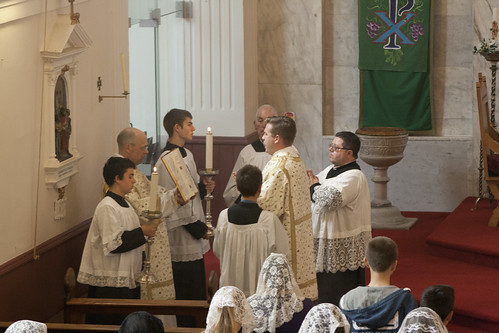 |
| Mantillas on display the St Catherine's Trust Summer School, a Mass at Holywell |
Support the work of the LMS by becoming an 'Anniversary Supporter'.
Richard Swinburne, homosexuality and the Society of Christian Philosophers
Support the work of the LMS by becoming an 'Anniversary Supporter'.
'You can't fight it'
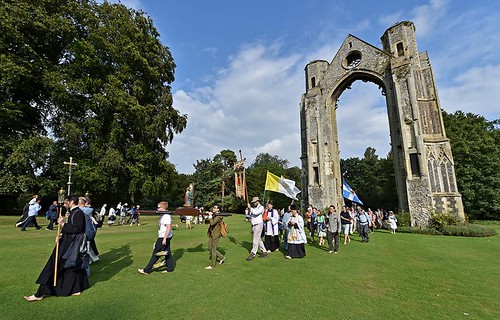 |
| An act of evangelisation: the LMS Pilgrimage to Walsingham |
I have to confess that developments over the last few years in the Church and the world have left me a little dispirited. Not all the news has been bad--far from it--but on a series of issues fundamental to the continued possibility of civilised life, the forces ranged against sanity have, at present, considerable momentum. Not only is it difficult to see how they can be defeated on the current balance of forces, but the balance of forces is becoming progressively less favourable as time goes on.
To give an example from secular politics, here in the UK we have no serious political party which supports anything recognisable as social conservatism. To give an example from the Church, although numbers attending Mass have been bolstered by immigration, the decline in marriages celebrated in church continues. On previous occasions when, after all kinds of difficulties, the Church has experienced a great revival, it has been because Catholic families survived the crisis in sufficient numbers to provide the priests, lay leaders, reformers, and above all the foot-soldiers of a revived Church in the new situation. How many faithful Catholic families are there going to be, in England and Wales or indeed anywhere in the West, in 20 or 30 years' time?
Come to that, how many are there now? How many nominal Catholics have any serious formation in the Faith, as would have been taken for granted sixty years ago? How many believe the less popular doctrines? How many seriously aspire to a morally well-ordered lifestyle? And how many are free from intense pressure to conform to the false maxims of the World?
The work we can do in the Vineyard of the Lord is, for each of us, of negligible overall effect, in relation to the huge trends which I been noting. I rather think this is even true for Bishops, perhaps even for the Pope. A good Pope with good ideas applied with vigour would, of course, do good, but he won't necessarily change the course of history. I think of Pope Leo XIII, for example, or Pius IX, or St Pius X. These weren't just good Popes, they were men of great intelligence and education, acutely attuned to the problems of their day, who furthermore wielded considerable power with great energy, for a long term of office. One can hardly say that they lived in vain, but nor did they turn the tide. It is given to few human beings to do such a thing.
A great many Catholics, or nominal Catholics, have taken the obvious conclusion: you can't fight it. The particular thing right now they are declining to fight is gender ideology, despite the repeated and powerful protests of Pope Francis on this issue--protests many of his self-described supporters would rather not hear. But they have been failing to fight the secularisation of Catholic education, the culture of death, liturgical anarchy of all kinds, and a host of other things, for a long time now. It is tiring to keep up the fight. And if you show a bit of enthusiasm for the other side of the argument, the world will often reward you well.
To avoid despair, I want to make two distinctions. The first is between our duty as Catholics and worldly success. Our duty as Catholics is to live in accordance with God's (and the Church's) law, and give witness to the Gospel according to our abilities and opportunities. It is not to convert X number of heathens, or be part of an expanding parish, or even to knock on a certain number of doors like the Jehovah's Witnesses. It can be very hard work doing what we are obliged to do, and it is made harder by all kinds of trends and developments, but it is not something which will ever become impossible. The task we have been given to do--to cooperate in our own salvation--is not only not impossible, but we are actually guaranteed the necessary graces, and told that this burden is light, this yoke easy, in the sense that with that grace we will be able to do it without regrets, with joy, knowing that life in God's friendship is preferable to life without God's friendship, regardless of the possible worldly disadvantages of the former over the latter. We aim make a success of our particular projects, but that success, at least by any tangible measure, is not necessary to the success of our lives as Catholics.
The other distinction is between trends in the world and developments in the Church. It is possible that the governments of the world will adopt the most pernicious principles and remain wedded to them for centuries to come. That is not possible in the Church. Catholics and their allies can be comprehensively defeated in the political arena--and this has indeed often happened--but it is not possible that Christ will allow his bride to be taken from him.
Throughout history there have been those who have wanted to efface the teaching of the Church and replace it with falsehood, and right now we are facing a particularly powerful and concerted effort to do this. It will not succeed. In past crises there have been mass defections to heresy by members of the clergy, by bishops, and by whole national populations of the laity (as happened with Protestantism), but when the dust settles the Church, and her teachings, remains. Even if the Pope falls silent, even if he allows himself to pronounce ambiguous formulations or indeed outright error (I'm thinking, of course, of Pope Honorius and Pope John XXII), the teaching of the Church does not change, the Church remains, and the visible, human aspect of the Church recovers from the crisis.
So in these two senses, it is not at all true that 'you can't fight it': as far as our own lives are concerned, our own living according to the truth, and insofar as the fate of the Church as an institution is concerned, the opposite is true. For ourselves, the battle can go either way: there is everything to fight for. For the Church, victory for the truth is actually guaranteed.
Indeed, the frustration of the opponents of the Church's teaching not infrequently breaks through the facade of optimism. They think the Church must be conformed to the world, and it just won't. They can't control all of the people, not even all of the bishops and cardinals, and they can't erase the historical record of the Church's teaching, and if the people were silent the stones themselves would proclaim the kingship of Christ.
In the meantime of course they do great harm to souls, and it is our obligation to oppose them with every lawful means available. If they want to win, though, they need to give up on the Church and join a political party.
I've recently read two helpful articles on related matters, which I recommend. Pat Archbold on 'The Most Radical of Traditionalists', and Fr David Nix on 'The Birth Pangs of the Church'.
Support the work of the LMS by becoming an 'Anniversary Supporter'.
Traditional Confirmations in London: not too late to book for November
Confirmation in the Traditional Rite will take place in St James', Spanish Place, in London, on Saturday, November 12 2016, organised by the Latin Mass Society.
Bishop John Sherrington, Auxiliary Bishop of Westminster and Titular Bishop of Hilta, will confer the Sacrament of Confirmation in the Traditional Rite on Saturday 12 November 2016, at St James Spanish Place, London at 11.00am. This will be followed by Pontifical Benediction.
If you would like more information about Confirmations in the Extraordinary Form, or would like your child, or yourself, confirmed, please contact the LMS Office on020 7404 7284 or email us.
To register your child or yourself, see here for further details.
Support the work of the LMS by becoming an 'Anniversary Supporter'.
'Declaration of fidelity to the Church's unchangable teaching on marriage'
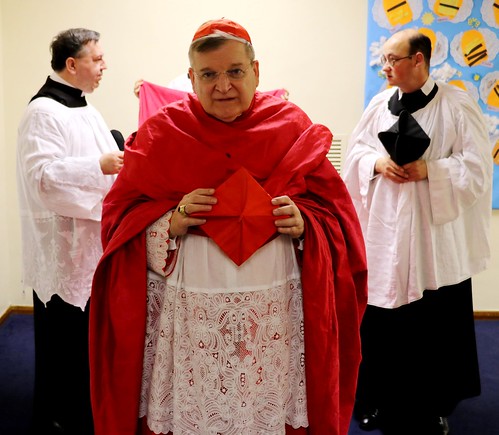 |
| Cardinal Burke with the LMS last year. Photos: Daniel Blackman |
You can join Cardinals Burke and Caffara, Bishop Athanasius Schneider and many others in signing a detailed declaration on the teaching of the Church on marriage, divorce, and related matters here. Although it makes for a long read, I do encourage people to sign it.
It is being promoted by the people who did the 'filial appeal' before the last Synod on the Family.
It is a magnificent piece of work. Each of 27 paragraphs about a particular issue is supported by several quotations from magisterial documents: Pope St John Paul II, Pius XI and XII, instructions from the Congregation for the Doctrine of the Faith, and so on. They provide irrefutable proof of the solidity of the traditional understanding of the teaching and practice of the Church, and the necessity of the practice in light of the teaching, with crystal clear condemnations of many of the proposals floating about today. It thus makes for a very informative teaching document in itself.
Not being a specialist in this material I didn't know all of these documents before now. Particularly interesting to me were the quotations not only from Pope St John Paul II's Veritatis splendor, but his 1984 Reconciliatio et paenitentia, and the extremely helpful Declaration from the Pontifical Council for Legislative Texts, Communion of faithful who are divorced and remarried. This last is not exactly ancient history: it dates from the year 2000! You'll find it on the Vatican website here.
See what that one says about Catholics whose lives give public scandal even after they have repented and had sacramental absolution: couples in illicit unions who have undertaken to live as 'brother and sister', since they cannot separate:
Those faithful who are divorced and remarried would not be considered to be within the situation of serious habitual sin who would not be able, for serious motives—such as, for example, the upbringing of the children—‘to satisfy the obligation of separation, assuming the task of living in full continence, that is, abstaining from the acts proper to spouses’ (Familiaris consortio, n. 84), and who on the basis of that intention have received the sacrament of Penance. Given that the fact that these faithful are not living more uxorio [as man and wife] is per se occult [i.e., since they are sharing a house so people will assume they are still living as man and wife], while their condition as persons who are divorced and remarried is per se manifest [i.e. it is a public fact that they are not married to each other], they will be able to receive Eucharistic Communion only remoto scandalo [in such a way as won't cause scandal, e.g. privately]…. In those situations, however, in which these precautionary measures have not had their effect or in which they were not possible, the minister of Communion must refuse to distribute it to those who are publicly unworthy. They are to do this with extreme charity, and are to look for the opportune moment to explain the reasons that required the refusal. They must, however, do this with firmness, conscious of the value that such signs of strength have for the good of the Church and of souls…. Bearing in mind the nature of the above-cited norm (cfr. n. 1), no ecclesiastical authority may dispense the minister of Holy Communion from this obligation in any case, nor may he emanate directives that contradict it.
A dispute among philosophers
The Jewish philosopher Yoram Hazony, quioted by Rod Dreher, puts it well.
The Society for Christian Philosophers posts an apology for a lecture given by the distinguished Christian philosopher Richard Swinburne that included his views on homosexuality. Personally, I find it painful to see a senior scholar such asSwinburne being apologized for in public. I often disagree with his views. But if we’re assessing pain, it hurts to see him being shamed in this way for taking a side in a philosophical and religious controversy. What are we trying to do–create a world in which philosophers are only permitted to express certain views? Isn’t the traditional response to write an essay arguing with him, rather than posting an apology?
Philosophers love arguing. What is surprising is to see one telling another, in as many words, that he is wrong, not because of a faulty argument, but because his conclusion doesn't accord with political fashions. At least, this is unusual among Christian philosophers of great prestige and experience, as opposed to bickering sophomores.
I may have more to say about this, but for the moment here's an account of the controversy, and here is Edward Feser and Rod Dreher. This is the original person trying to shout my old DPhil supervisor, Prof Swinburne, down. And here is an open letter criticising the critics of Prof Swinburne, which I have signed.
Support the work of the LMS by becoming an 'Anniversary Supporter'
Beauty and virtue
My philosophical interlude about fashion continues: part 1 is here.
In the last post about fashion, Queen of Puddings said that if we focus on beauty, modesty will follow. This was qualified by noting that the judgments about beauty we should be making are judgments by people who value modesty. To put the matter more simply, what is at issue is a correct understanding of beauty. It will take into account all the things relevant to the object at issue.
The commenter Timothy Graham (here) makes a good point, that in our theological sources 'modestia' is not primarily about avoiding sexual sins. (That would be 'continentia.' The contrast would be with 'luxuria', whereas the contrast with modestia is 'vana gloria'.) Of course avoiding giving scandal to others, causing them unnecessary temptation, is an issue in this fallen world, where we are afflicted with sinful concupiscence: the desire for sinful pleasures, which Adam and Eve did not have. (Which is why they had to be tempted by the Devil, and not just by their own desires springing from within.) The point is that, where clothes are concerned, the 6th and 9th Commandments are only a part of what we should be thinking about, and while setting limits to what we can wear, it is not the most important issue. The most important issue is how the clothes make us look. Will anyone disagree with this? Once we exclude clothes which excite lust, we choose clothes which are appropriate and becoming, for the occasion at hand.
What makes one thing beautiful does not make another thing beautiful. As Plato observed, if you think purple is the most beautiful colour, you still shouldn't try to beautify a statue by painting the eyes purple. 'Euphronsia' keeps telling us that the naked body is beautiful. It certainly can be. But it would be out of place at a cocktail party. In that context it does not have the beauty we are concerned about.
Catholics are concerned with beauty in this complex sense. There are many things which are beautiful in some contexts which are not appropriate to the liturgy, for example - such as operatic styles of music. We can even say that such music is not beautiful in the liturgy. This is perhaps best expressed by saying that it doesn't accord with good taste. A flower in the wrong place is a weed.
So we can talk about beauty, in this complete sense, and put it into the driving seat when we think about clothes. It has a certain relationship with the customs of the day, because we don't want to appear outlandish: what is outlandish lacks good taste. We can make generalisations about it in a number of respects. But we can't codify it. That is, you can't write a complete and self-interpreting rule-book.
This may be a disappointment to Catholics who want concrete guidance; the only genuine guidance will be vague and incomplete. This isn't because we need to read (or write) a bigger book, but because of its nature. Being able to get it right is being able to exercise a skill, which is also a virtue. The same is true of all the natural virtues: of prudence, justice, fortitude, and temperance, or indeed courage and friendship. You don't get them out of a book, but from training, practice, habituation: ideally, in the course of a good upbringing.
If natural virtues are cultivated by practice, in the case of good sense about clothes, this involves taking notice of clothes, learning about them, seeing what others wear and what works and what doesn't work, and thinking about why, and by following good example. We don't have to be rude to anyone, but we must allow ourselves to be discriminating.
No one became a great artist by looking at every painting and saying 'sure honey that's nice' and turning back to his newspaper.
One thing Traditional Catholics have certainly got right about modesty is that it is a moral issue. It is part of the moral life, and it is not just about 'what feels right to you'. But it is possible for Catholics to slip into the idea that important moral issues are simple ones, because we can appeal to a number of absolute moral prohibitions. There are some in the area of modesty - 'Don't go out naked' would be an obvious one. But these prohibitions are not the whole of the moral life, and in many situations give very limited guidance. The moral agent lacking prudence (practical wisdom) is going to make a lot of mistakes however tightly he grips his copy of a pre-Conciliar handbook of moral theology.
Prudence takes time to develop; it includes many practical skills and knowledge specific to our particular circumstances. There is prudence about money; there is prudence about relationships. It would be pretty surprising if there were not a prudence about clothes.
To return to the beginning, prudence in the area of clothes is about beauty rightly understood. It is being able to find the right clothes for the occasion, clothes which are beautiful - or, you prefer, just 'nice'. Readers who think this means highly elaborate or decorated or formal or expensive clothes, are reading something in here which I have not said. Such clothes would be out of place in many situations, and thus ruled out. Simple, inexpensive, and practical, need not mean ugly.
To reiterate something emphasised more than once before in this series, the attitude we wish to oppose comes from an ideology of ugliness. The ideology which says that if you've made the effort to put on nice clothes, you can't be relaxed, you can't be cool, you can't be an authentic person. The problem is not people not having the money to buy nice clothes. It is not a lack of beauty by accident which is the big problem, it is the lack of beauty on purpose.
I have said the same about liturgy, and the parallel is worth remembering. We want the best for the liturgy. That doesn't mean that poor liturgy which is the result of a lack of resources and skills shows a moral failure on anyone's part. If they have struggled against the odds to do as well as they have, this may have greater merit than many more splendid celebrations, as was certainly the case with many Masses in concentration camps. But those who say that it is the effort and not the result which is important actually imply that the effort wasn't worth it. The outward beauty is the objectively appropriate form for the liturgy and we approximate it to the best of our abilities, we make the effort. Poor liturgy which results from people not making the effort is offensive to God.
If we reject the cult of ugliness, we need to start thinking about beauty. If we want to do something about it, we need to develop a prudence, a practical wisdom, about clothes which will take time and effort - just like the time and effort needed to make beautiful vestments, to sing Gregorian Chant well, or to make nice food for one's family.
I'm in Chinese!
Over the Summer I gave an interview to a Macau-based publication; the interviewer was an Italian journalist, Antonio Porfili. You can see it here.
This has now appeared on a Chinese website, in Chinese - above is a screen shot. One fun thing is that I have been given a Chinese name - a version of my name which can be written in Mandarin. I can't read a word of Chinese, but I'm told it works like this:
I do know that the convention in China is to put the surname first. So if I ever travel East, I shall introduce myself as 蕭若瑟.
At least I would, if I could say it without embarrassing myself!
At any rate, the spread of this humble interview is a nice demonstration of the univerality of the Church, and the interest the Traditional Mass, and doctrinal orthodoxy, has in China. Read my post on the Position Paper on the Extraordinary Form and China here.
Support the work of the LMS by becoming an 'Anniversary Supporter'.
Fr Longenecker, the Latin Mass, and the magic bullet
Reposted from October 2015.
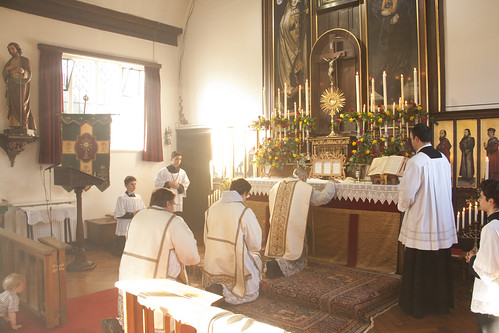 |
| An act of revence during Mass before the Blessed Sacrament Exposed, for Corpus Christi: it tells us something, does it not? (What does the little chap on the left think?) |
Further to my post the other day someone noted a recent post on this topic by Fr Dwight Longenecker: 'Is the Latin Mass a Magic Bullet?'. In it he attempts to put the thoughts of those 'conservative' Catholics who don't much like the Traditional Mass, about the relationship between the crisis in the Church and the liturgy, into order. The result is fascinating. Some key quotes, with a few comments of mine in black.
The problems in the Catholic church are not due to lack of reverence at Mass. The lack of reverence at Mass is due to the problems in the church. But it can't help, can it?
Simply obeying the rubrics or performing the Mass in this direction or that direction or standing here or there or wearing this particular vestment or that particular vestment or holding your fingers together there and bowing properly there do not necessarily make a Mass reverent. It makes the Mass more formal. .... So what's the point of them?
Here is my main point: I think those who blame all the problems of the church on the Novus Ordo are simply missing the point. If there are things wrong with the Novus Ordo they are symptoms, not causes. The core problem in the church is not the Novus Ordo or the liturgical abuses or the bad hymns and liturgical dance and all that awful stuff. So why exactly are these things 'awful'?
The reason the Novus Ordo so often seems irreverent is not any intrinsic deficit in the Novus Ordo. (otherwise why would Holy Church say that it remains the Ordinary Form of the Mass?) Instead the Novus Ordo is sometimes celebrated irreverently because people regard the Mass as a celebration of their social activism, or a community festival to increase their self esteem or a sentimental, individualistic, spiritual comfort session. They have ceased to really believe in sin and grace and a God who saves, and instead they look to one another for their salvation. So there’s not much reverence required there. Aren't these beliefs reinforced by the abuses which express them?
The phrase 'lex orandi lex credendi' clearly doens't resonate with Fr Longenecker. Whether he realises it or not, he goes far further than simply dismissing the straw man claim he started with ('Some traditionalists also seem to think that all the church’s problems would be solved if only we would all return to the Latin Mass everywhere and at all times.': dude, I don't believe you have friends as stupid as that). His position appears to be the opposite extreme: that liturgy has no impact at all on the spiritual lives and religious attitudes and beliefs of the Faithful.
This is a claim of such utter insanity that I can't imagine Fr Longenecker consciously espouses it. But if he simply thought: 'Of the influences on Catholics, catechesis is on balance more important than the liturgy', then his conclusions would not follow. If the liturgy has some influence, then it would be at least part of the explanation for the strange phenomenon of well-catechised Catholics clustering around one Form of the Mass; at least part of the cause of the problems in the Church; and so on. He would, in short, find himself expressing a position we could all agree with.
The influence of the liturgy on the spiritual lives and on the dogmatic beliefs of Catholics is a constant theme of the Church's teaching on the liturgy. I could point to a score of references in the Magisterium, and it a major theme in Cardinal Ratzinger's writings. That a priest should be betrayed into suggesting, even inadvertently, that the liturgy makes no difference to what people end up believing is itself a symptom of a deep malaise in the Church.
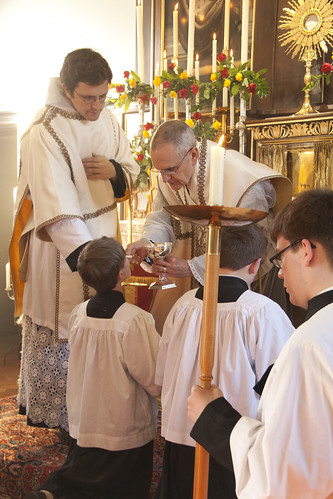 |
| A reverent form of receiving Communion, which expresses the belief we have about it: or just an empty formality? |
I would hope that all minimally sane Catholics would immediately agree that a range of things influence our spiritual lives and beliefs. Catechesis is one, but there are many others: our experience of religious art; cultural references of all kinds; newspapers, blogs, and books, including spiritual reading and study; the example of others; conversations; our own spiritual endeavours and experiences; and of course the liturgy. Looking at a community, or indeed the world-wide Church, we will expect to find these influences interacting, reinforcing or counteracting each other as time goes on. A big push by one or a group of them can draw the others in their wake: conversations take off from what we've read, the liturgy can be influenced by conversations, catechesis can be influenced by the liturgy (think of all those theologically weird hymns), catechesis stimulates spiritual writing or Catholic journalism or blogging, and round it goes again.
What Cardinal Ratzinger, and for that matter Pope Pius XII in Mediator Dei, and Vatican II, and the whole Magisterium, is telling us is that the liturgy is not just a small part of this process: it can't be dismissed as an epiphenomenon, a 'sympton not a cause': no, it is of central importance. It's not the only thing - that idea is just silly - but it is, to coin a phrase, the source as well as the summit of the Christian life. (Many readers will know I'm paraphrasing not some loony trad, but Vatican II.)
Fr Longenecker should reflect on the fact that while all practising Catholics hear (if not actually listen to) sermons, adult Catholics are completely immune to systematic catechesis, except for temporary and atypical situations like marriage preparation. Your exciting new catechetical tools are not going to reach adults; the ones still practising, however, are going to be influenced by the liturgy. Even people who think that liturgy is a less powerful tool than catechesis in conveying theological ideas and habits of prayer, should still recognise its supreme value for those not in any kind of catechetical program, which is almost all adult Catholics.
I find it deeply disturbing that Fr Longenecker and others like him should be so deaf to Vatican II and the rest of the Magisterium on the importance of the liturgy. We seem to have bred up a generation of 'conservative' Catholics who are simply non-liturgical in their thinking. It doesn't make sense, of course, to say that you are in favour of things like Latin and worship ad orientem if you think they make no contribution to the reverence, the worthiness, of the liturgy. The contrast he offers between reverence and formality is, well, amazing, and I'm sorry he didn't have the time to explain what he means. He appears to think that the rubrics of the Mass have no meaning and convey nothing to the onlooker. The outlook all this suggests is mind-boggling.
But Fr Longenecker is in favour of Latin and ad orientem worship and welcomes the spread of the Traditional Mass, so looking at this incoherent position from the other end, it would follow that he cannot believe that it makes no difference, has no positive effect on the faithful, is not a more reverent act of worship to offer God, and so on. So I suppose we just have to leave Fr L suspended between the two positions, like a novice trapeze artist.
The rest of us, however, can hold fast to the fact that the Mass is the central mystery of our spiritual lives. The offering of the Unbloody Sacrifice with beauty and reverence, and in continuity with our predecessors in the Faith, is of fundamental importance in itself, and of fundamental importance for us. We know from experience what we are taught by the Church in the magisterium, that the liturgy is a 'school of prayer', that it is capable of softening the hardened heart, of consoling us and giving us strength to live our Christian lives. It puts us in direct touch with God in a way that nothing else can: not even the personal religious experiences of the great mystics can compare with the experience of Christ, really and objectively present upon the Altar and offered to the Father as a sacrifice for the sins of the world.
Experiencing this mystery, being able to grasp deep down that this is what is going on, is not guaranteed by the sacramental validity of the rite. I can feel the anger of the neo-cons rising as I write these words: how dare I say that the supernatural mystery of the Mass is less visible, is harder to experience, in a vernacular celebration larded with abuses? Sorry, guys, it is a fact we have all experienced; don't take it out on me, take it out on the Congregation for Divine Worship:
... abuses “contribute to the obscuring of the Catholic faith and doctrine concerning this wonderful sacrament”. Thus, they also hinder the faithful from “re-living in a certain way the experience of the two disciples of Emmaus: ‘and their eyes were opened, and they recognized him.’”
Or better still, take it out on St John Paul II:
In various parts of the Church abuses have occurred, leading to confusion with regard to sound faith and Catholic doctrine concerning this wonderful sacrament.
If the mystery is not vividly conveyed to you in Mass, perhaps you should try coming to the Traditional Mass.
A critique of a related opinion of the late Cardinal Hume on reverence and Latin can be found here.
Photographs from SS Gregory & Augustine; more on this Mass here.
Support the work of the LMS by becoming an 'Anniversary Supporter'.
Mass in Snave, the Kentish 'Marsh church', this Saturday
This Saturday - A Missa Cantata in the marshes. (Click for a map.)
For only the second time since the reformation, St Augustine's in Snave, a medieval Kent church will hold a Latin Mass this Saturday 24th September at 12 noon.
This is an extremely important event because last year was the first time since the Reformation that Mass was celebrated in the church.
Snave is one a group of medieval churches built to serve very small communities on Romney Marsh in Kent. Now redundant, they are in the care of the Romney Marsh Historic Churches Trust
The celebrant will be Fr Marcus Holden (Rector of the Shrine of St Augustine, Ramsgate) and music will be supplied by The Victoria Consort.
Support the work of the LMS by becoming an 'Anniversary Supporter'.

